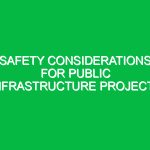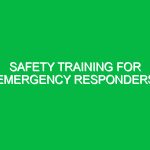Introduction
Emergency preparedness for natural disasters is an essential aspect of health, safety, and environment (HSE) management. It encompasses a systematic approach to planning for potential disasters, ensuring that individuals, organizations, and communities can effectively respond to emergencies such as hurricanes, earthquakes, floods, and wildfires. The significance of emergency preparedness cannot be overstated; it not only protects lives but also mitigates property damage and promotes swift recovery. With climate change increasing the frequency and severity of natural disasters, understanding how to prepare for such events is more critical than ever.
This article delves into the various hazards associated with natural disasters, outlines safety precautions, and discusses the relevant regulations and standards that govern emergency preparedness. By equipping yourself with knowledge and actionable strategies, you can enhance your resilience in the face of unpredictability.
Identifying Hazards and Risks
Natural disasters come in many forms, each presenting unique hazards and risks. Understanding these can help individuals and organizations tailor their emergency preparedness plans.
1. Hurricanes and Tropical Storms
Hurricanes pose a significant threat, characterized by high winds, heavy rainfall, and storm surges. They can lead to flooding, property damage, and even loss of life. The risk is especially prevalent in coastal areas, where storm surges can inundate homes and infrastructure.
2. Earthquakes
Earthquakes can strike without warning, causing buildings to collapse and triggering landslides or tsunamis. Areas along tectonic plate boundaries are particularly vulnerable. The unpredictability of earthquakes means that preparedness must focus on structural safety as well as emergency response.
3. Floods
Flooding can result from heavy rainfall, melting snow, or hurricanes. It can occur slowly or suddenly, impacting large areas and causing extensive property damage. Floodwaters can also carry hazardous materials, leading to health risks.
4. Wildfires
Wildfires, often fueled by dry conditions and strong winds, can spread rapidly, threatening homes and ecosystems. The smoke from wildfires can pose health risks, particularly for vulnerable populations such as the elderly or those with respiratory conditions.
5. Tornadoes
Tornadoes can form quickly and wreak havoc in a matter of minutes. Their extreme winds can uproot trees, obliterate structures, and pose severe threats to life. Understanding tornado-prone areas is crucial for effective emergency planning.
6. Winter Storms
Severe winter storms can lead to blizzards, ice storms, and extreme cold. These conditions can disrupt transportation, cause power outages, and pose health risks due to exposure to cold temperatures.
Safety Precautions and Best Practices
With a clear understanding of potential hazards, the next step is to implement safety precautions and best practices for emergency preparedness.
1. Create an Emergency Plan
Developing a comprehensive emergency plan is vital. This plan should outline evacuation routes, safe meeting points, and communication strategies. Include contact information for local emergency services, family members, and friends. Regularly review and update the plan to reflect any changes in your circumstances.
2. Assemble an Emergency Kit
An emergency kit should contain essential supplies to sustain you and your family for at least 72 hours. Include items such as water, non-perishable food, first aid supplies, flashlights, batteries, and personal hygiene products. Don’t forget any necessary medications and important documents.
3. Stay Informed
Utilize technology to stay informed about potential threats. Sign up for local alerts and notifications, and follow weather forecasts from trusted sources. Awareness can significantly reduce panic during an emergency situation.
4. Conduct Drills
Regularly practicing your emergency plan through drills can ensure everyone knows their roles and responsibilities. This preparedness can make a significant difference during a real disaster, reducing confusion and stress.
5. Secure Your Property
Take proactive steps to protect your home and property from natural disasters. Reinforce windows and doors, clear gutters, and ensure that your property is free from debris that could become hazardous during a storm. If you live in a flood-prone area, consider flood barriers or sandbags.
6. Community Involvement
Engage with your community to foster a culture of preparedness. Participate in local emergency preparedness programs and collaborate with neighbors to develop a community response plan. Strong community ties can enhance resilience during disasters.
7. Mental Health Considerations
Disasters can take a toll on mental health. It’s crucial to have strategies in place to support emotional well-being. Consider resources such as counseling or support groups, and ensure that these are included in your emergency plan.
Regulations and Standards
Emergency preparedness for natural disasters is governed by various regulations and standards that aim to protect public health and safety. Understanding these can help organizations comply with legal requirements and enhance their preparedness efforts.
1. The National Response Framework (NRF)
The NRF outlines how the nation responds to all types of disasters and emergencies. It emphasizes the importance of preparedness, response, recovery, and mitigation efforts. Understanding this framework can guide organizations in developing their emergency plans.
2. Occupational Safety and Health Administration (OSHA)
OSHA provides guidelines for ensuring workplace safety during emergencies. The standards include training requirements, hazard communication, and emergency action plans, which are essential for businesses to protect their employees.
3. Federal Emergency Management Agency (FEMA)
FEMA offers resources and programs to support emergency preparedness at the local, state, and national levels. Their guidelines help communities develop disaster response strategies and provide information on funding opportunities for preparedness initiatives.
4. State and Local Regulations
Many states and municipalities have their own regulations pertaining to emergency preparedness. These can include building codes designed to withstand specific hazards and local emergency management plans. Familiarizing yourself with these regulations is essential for compliance.
Conclusion
Emergency preparedness for natural disasters is not just a box to check; it is a critical component of health, safety, and environmental management. By understanding potential hazards, implementing safety precautions, and adhering to relevant regulations, you can enhance your preparedness efforts and ensure the safety of yourself and your community.
As weather patterns continue to shift and the threat of natural disasters looms larger, taking proactive steps today can make all the difference in tomorrow’s emergencies. Whether you are a homeowner, a business leader, or a community organizer, your role in fostering a culture of preparedness is vital. Embrace the challenge, equip yourself with knowledge, and contribute to a safer future for all.


